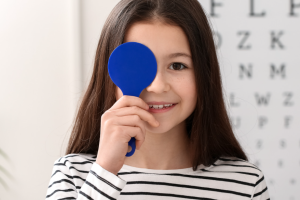Step one in myopia management can be as easy as getting a lens on the eye, Dr. Justin Kwan shares. From there, you can let the technology speak for itself.
By Justin Kwan, OD, FAAO
Prior to day one of my Cornea, Contact Lens, and Dry Eye Residency in July 2009, I had only fit one patient with keratoconus in corneal gas permeable (GP) lenses under clinical faculty supervision as a fourth-year intern. Sitting in the classroom with the third-year students, I distinctly remember Dr. Tim Edrington teaching the students to convey four simple things to a newly diagnosed patient with keratoconus. But in terms of restoring the patient’s vision, we are of no service until we follow Dr. Edrington’s simple piece of advice, “Get a lens on the eye.” From there, you can take inventory if the base curve is steep enough, if the edges are flaring out, and just how stable the lens is, even before adjusting the power for the best vision possible. And the fluorescein pattern is your poor man’s corneal topography.
As a novice corneal GP lens fitter, I definitely got into my own head that I didn’t have the experience or knowledge to produce the best first, let alone final, order for this patient who was depending on me for their everyday vision. But by getting a lens on the eye, I’d started and moved that patient closer to the finish line. The depth of gratitude expressed by these patients is so incredibly rewarding.
The same can be said for MiSight® 1 day for age-appropriate children*. While an 8-year-old child may be the last patient you imagined fitting in daily disposable soft contact lenses, their future eye health risk is in our hands. From start to finish, we can observe 8-year-old twins Olivia and Madeline successfully tackle application and removal training and then thoroughly enjoy wearing MiSight® 1 day in their everyday lives, from gymnastics to the playground. They probably are not clued into the benefits of myopia control, but their smiles never get old.
In this collaborative model of healthcare, optometrists and ophthalmologists must uphold myopia management as standard of care, declared by the World Council of Optometry in April 2021.1 To quote Nathan Cummings, “Nothing will be achieved if all obstacles must first be overcome.” Get a lens on the eye, and let the child and technology speak for themselves. Their future vision is worth protecting.

Justin Kwan, OD, FAAO, is the senior manager of myopia management for CooperVision. Dr. Kwan is a 2009 graduate of Berkeley Optometry and went on to do a contact lens and dry eye residency at Southern California College of Optometry.
*Indications for Use: MiSight® (omafilcon A) daily wear single use Soft Contact Lenses are indicated for the correction of myopic ametropia and for slowing the progression of myopia in children with non-diseased eyes, who at the initiation of treatment are 8-12 years of age and have a refraction of -0.75 to -4.00 diopters (spherical equivalent) with ≤ 0.75 diopters of astigmatism. The lens is to be discarded after each removal.
1.Resolution: The Standard of Care for Myopia Management by Optometrists. World Council of Optometry. https://worldcouncilofoptometry.info/resolution-the-standard-of-care-for-myopia-management-by-optometrists/. April 13, 2021.








